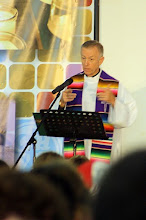Our theology of the waters of baptism dove-tails (pun intended!) nicely with that of the Greek Orthodox as presented in today’s Mobile Press-Register, in its feature on Fr Elias Stevens of Annunciation Greek Orthodox Church here. His blessings of homes in this Epiphany season involves holy water—“When [Jesus] was baptized…he sanctified all waters,” he said.
Our liturgy proclaims the same thing. When we use the Asperges or sprinkling-rite in place of a penitential rite at the beginning of Mass (typically in Easter season), the prayer of blessing also says: “You made the water of baptism holy by Christ’s baptism in the Jordan: by it you give us a new birth and renew us in holiness.”
How many of us remember that when we come to church and dip our hands into the holy water stoups we are re-claiming our baptism? Here at Our Savior there is no other stoup except the font itself, the more easily to remind folks of this fact. We are in effect taking Jesus Christ as our personal Lord and Savior every time we enter the church and make a bodily YES to our commitment to Him. In the same way, when we process forward to receive the Eucharist during Mass, we say AMEN to the declaration “The Body/Blood of Christ.” Once again, we make our personal YES…
All this we celebrate in origin today with the Solemnity of the Baptism of the Lord. He is Lord (and He is our Lord) forever and ever!
Today’s illustration is from a 5th century baptistery in Ravenna, Italy.


Because I had often wondered about the actual scene of the Baptism of Jesus, I referred to the Catechism of the Catholic Church. John the Baptist preached "a baptism of repentance for the forgiveness of sins."
ReplyDeleteA crowd of sinners - tax collectors & soldiers, Pharisees and Sadducees, and prostitutes -come to be baptized by him. "Then Jesus appears." The Baptist hesitates, but Jesus insists and receives baptism. Then the Holy Spirit, in the form of a dove, comes upon Jesus and a voice from heaven proclaims the familiar words: "This is my beloved Son". This is the
Epiphany or manifestation of Jesus as Messiah of Israel & Son of God. Jesus allows himself to be numbered among sinners! The Father's voice responds to the Son's acceptance, proclaiming his total delight in his Son.
Historically, the Liturgy celebrated three "feasts" on the one day of Epiphany: Jesus' "manifestation/revelation" to the Magi, at the Baptism, and at the wedding in Cana. Antiphons for the Gospel canticles of Morning and Evening Prayer still reflect this combined celebration.
ReplyDelete